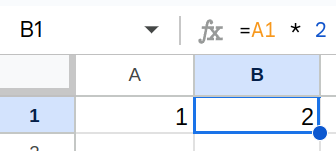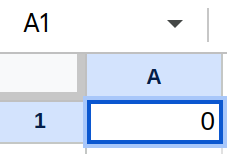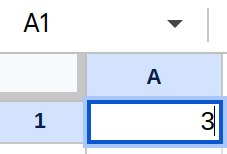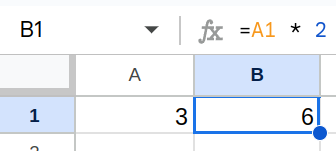Chapter 1: FRP is like Spreadsheet
Another familiar example of something fundamentally designed to keep its versions perfectly synchronized is the spreadsheet.
And the FRP library being introduced here, Timeline , will be easier to understand if this spreadsheet principle is kept in mind.
Timeline provides binary operations to utilize the state management
Section titled “Timeline provides binary operations to utilize the state management”In Functional Programming, everything is an expression or operation. Accordingly, Timeline library provides binary operations for the reactive state management .
This binary operation corresponds to an operation in spreadsheet apps.


🔍 Functions
Section titled “🔍 Functions”① Function to initialize Timeline<'a>
Section titled “① Function to initialize Timeline<'a>”Timeline
Section titled “Timeline”'a -> Timeline<'a>let counter = Timeline 0Consider the Timeline as a specific container for a value, similar to a Cell in spreadsheet apps.

② Functions for the binary operations
Section titled “② Functions for the binary operations”TL.map
Section titled “TL.map”('a -> 'b) -> (Timeline<'a> -> Timeline<'b>)TL.bind
Section titled “TL.bind”('a -> Timeline<'b>) -> (Timeline<'a> -> Timeline<'b>)When the binary operator: TL.map,
let double = fun a -> a * 2
let timelineA = Timeline 1
let timelineB = timelineA |> TL.map double
log (timelineB |> TL.at Now)// 2This code for the binary operation simply corresponds to the basic usage of spreadsheet apps

This is the identical structure of:
let double = a => a * 2;
let listA = [1];
let listB = listA.map(double);
console.log(listB);// [2]
We could recognize the array [2] is identical to the Cell and Value 2 of a spreadsheet; however, the spreadsheet and Timeline maintain a double relationship as values change over the timeline .
③ Function to update Timeline<'a>
Section titled “③ Function to update Timeline<'a>”TL.next
Section titled “TL.next”'a -> Timeline<'a> -> unitlet timelineA = Timeline 1
timelineA |> TL.next 3
log (timelineA |> TL.at Now)// 3
①②③ action of Timeline<'a>
Section titled “①②③ action of Timeline<'a>”The update to timelineA will trigger a reactive update of timelineB according to the rule defined by the binary operation.

let double = fun a -> a * 2
// ① initialize timelineAlet timelineA = Timeline 1
// confirm the lastVal of timelineAlog (timelineA |> TL.at Now)// 1
// ② the binary operationlet timelineB = timelineA |> TL.map double
// confirm the lastVal of timelineBlog (timelineB |> TL.at Now)// 2
//=====================================// ③ update the lastVal of timelineAtimelineA|> TL.next 3// update to timelineA will trigger// a reactive update of timelineB
// confirm the lastVal of timelineA & timelineBlog (timelineA |> TL.at Now)// 3log (timelineB |> TL.at Now)// 6